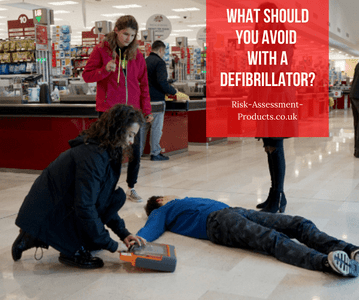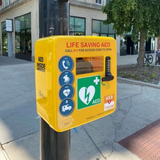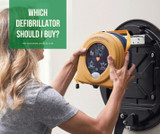What should you avoid with a defibrillator?
Defibrillators are lifesaving medical devices that are designed for use when someone suffers a sudden cardiac arrest. They can be found in public areas, schools, sports facilities, supermarkets, offices, and any other place of work up and down the country.
If someone collapses due to experiencing a cardiac arrest, defibrillators can be used by anybody meaning you do not have to wait for the emergency services to arrive. Specifically created with ease of use at the very heart of what they do, defibrillators have easy to follow guides to show users what to do in an emergency.
A defibrillator can be used on anyone over the age of one. There are specially designed paediatric defibrillators for children under the age of eight as they deliver a lower frequency shock. Many standard, adult defibrillators also come with electrode pads that are designed for children in case needed.
With this, you should avoid using adult electrode pads on children. They will always be clearly labelled however; it is important to remember that children require a lower shock level and so ensuring you put the correct electrode pads on is important.
Another thing to consider when it comes to using a defibrillator is to make sure you are away from water. As defibrillators may need to deliver an electric shock, you must make sure you or the patient is not in contact with any. This means removing wet clothing, taking them out of water and making sure they are not in any puddles. Fibrillation should always be carried out on a dry surface where possible.
There are other things to be mindful of when using a defibrillator. One should not be used if it has faulty, damaged, or missing parts. If you notice your defibrillator has any of these, you should flag it up and follow the necessary steps to replace parts or have it repaired.
It is also easy to confuse a heart attack with a cardiac arrest which means that sometimes defibrillators can be used in the wrong circumstances. Heart attacks are caused by a blockage in the heart’s arteries whereas a cardiac arrest is caused due to an electrical fault with the heart. Those who experience a cardiac arrest will fall unconscious and not have a pulse, this is not the case for heart attack sufferers.
If the victim has a pacemaker, you should also make note to not place the defibrillator directly on top. Pacemakers are often easy to stop as they form a hard lump in the patient’s chest and are roughly the size of half a deck of cards. If you need to use a defibrillator on somebody who has a pacemaker, just make sure it is placed as close to the heart as you can but without it being in contact with the pacemaker.
Overall, defibrillators save lives when a cardiac arrest occurs and if you are lucky enough to have one nearby, the chances of survival are as high as 90% when used in the first minute. As with any medical tool, it is important to always keep in mind a few safety measures to ensure you are always being as safe as possible. Ensuring your victim is out of water, you are using the correct electrode pads and that they are placed in the correct place are all steps that will ensure your patient has the best chance at making a recovery.
Recent Posts
-
Empowering Communities: The Lifesaving Impact of CPR on Restart a Heart Day
Every year, on and around October 16th, an important event takes place - Restart a Heart Day. This a …16th Oct 2023 -
Which home defibrillator?
80% of all out of hospital cardiac arrests occur at home. Defibrillators are often available in loca …4th Dec 2022 -
Which defibrillator should I buy?
There are many defibrillators available on the market and it can become overwhelming knowing which o …4th Nov 2022




